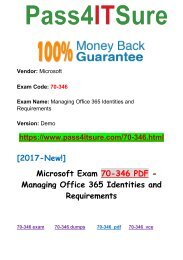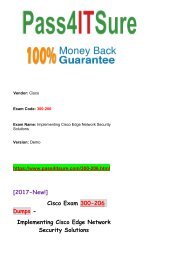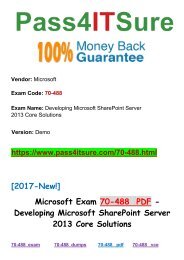New Pass4itsure Microsoft NSE8 PDF Exam 112Q Share
Provide Latest Fortinet NSE8 Dumps Preparation Materials, Real NSE8 Dumps Test Sale, Pass from google drive: https://drive.google.com/open?id=0BwxjZr-ZDwwWVDVZNHEtU3NubGs
Provide Latest Fortinet NSE8 Dumps Preparation Materials, Real NSE8 Dumps Test Sale, Pass from google drive: https://drive.google.com/open?id=0BwxjZr-ZDwwWVDVZNHEtU3NubGs
Create successful ePaper yourself
Turn your PDF publications into a flip-book with our unique Google optimized e-Paper software.
Pass4itSure IT Certification Braindumps<br />
https://www.pass4itsure.com/nse8.html<br />
[2017-NEW]<br />
<strong>NSE8</strong> <strong>PDF</strong><br />
Best Quality For Free Download<br />
RELEASED
The United State is by far the world leader in markets for both publicly traded securities and<br />
closely held<br />
businesses and business interests. Two factors have combined to accelerate the spread of<br />
U.S<br />
technology in financial appraisals and market throughout the world.<br />
Which of the following is/are of those factors?<br />
A. Rapidly increasing international flow of capital<br />
B. Growing privatization of formerly socially owned businesses in almost every country of<br />
the world.<br />
C. Increased inflation in major parts of the world<br />
D. Secondary market securities trading phenomenon<br />
Answer: A, B<br />
2.When specifying, who is to provide the valuation services, the important distinction is<br />
whether the client<br />
is retaining the appraisal firm itself or the individual appraiser employed by the firm.<br />
The common practice is:<br />
A. To retain the individual appraiser rather than the firm<br />
B. To retain the firm rather than individual appraiser, even though the expert witnesses<br />
testify based upon<br />
their individual expertise and opinions<br />
C. To retain the individual since the firm is responsible for completing the assignment<br />
regardless of<br />
impairment the individual ¯s capability to perform the work<br />
D. To retain firm as such practice also tends to provide discontinuity in retention of working<br />
papers and<br />
related records, marking them accessible if they are needed months or even yearslater as<br />
they frequently<br />
are<br />
Answer: B<br />
3.S corporations, limited liability corporations, limited liability partnerships, family limited<br />
partnerships,<br />
professional corporations, real estate investment trust, investment companies registered<br />
under the<br />
investment company act of 1940 and personal holding companies are the examples of:<br />
A. General and limited partnerships<br />
B. Cooperatives<br />
C. Entities ¯ structures giving rise to special legal or tax considerations (specified structure)<br />
D. Companies following valuation standards<br />
Answer: C
4.The definition of specific business interest can be broken down into two broad questions:<br />
1)-Is the valuation to be a valuation of assets or a valuation of securities?<br />
2)-In either case, exactly what assets or what securities are subject to valuation?<br />
By securities in above context, we mean:<br />
A. Ownership interests; such as marketable securities and commercial papers<br />
B. Ownership interests; such as stock, dept and partnership interests<br />
C. Partnership interests<br />
D. Equity or invested capital<br />
Answer: B<br />
5.Valuation of must be specified. For example, the assignment might include language such<br />
as ...engaged to estimate the fair market value of the fixed assets, inventory, and goodwill,<br />
on a going-concern basis of...<br />
A. Assets<br />
B. Securities<br />
C. Cooperatives<br />
D. Partnerships<br />
Answer: A<br />
6.Which one of the following is NOT always clearly defined? Therefore, if the term is used, it<br />
should be<br />
supplemented by a definition of exactly what it means in the given valuation context.<br />
A. Enterprise value<br />
B. Partial interest<br />
C. Invested capital<br />
D. Securities<br />
Answer: C<br />
7.Unfortunately, the term enterprise value is used, at best, very ambiguously and, at worst,<br />
very carelessly.<br />
It means different things to different people, each of whom many believe that his or her<br />
definition is the<br />
right definition.<br />
It is generally used to represent some sort of of the company and is often used as a<br />
synonyms<br />
for .<br />
A. Average value, Market value<br />
B. Aggregate value, Market value of invested capital (MVIC)<br />
C. Partial interest, Aggregate value<br />
D. Specific ownership interest subject to appraisal, Equity or invested capital
Answer: B<br />
8.The primary ownership interest characteristics that need to be addressed in almost every<br />
business<br />
valuation are the following EXCEPT:<br />
A. Control or minority valuation basis (not necessarily a black-and white issue there may be<br />
elements of control without absolute control<br />
B. Degree of marketability<br />
C. Fair market value<br />
D. Fair market value on a nonmarketable, non-controlling ownership interest basis.<br />
Answer: C, D<br />
9.In most business valuations, the opinion of value will be based at least partly on other,<br />
similar<br />
transactions, such as:<br />
A. Prices at which stocks are denominated<br />
B. Degree of marketability<br />
C. Prices at which stocks in the same or a related industry are trading in the public market<br />
relative to their<br />
earnings, assets, dividends or other relative variables<br />
D. Black-or-white issues<br />
Answer: C<br />
going-concern basis of...<br />
A. Assets<br />
B. Securities<br />
C. Cooperatives<br />
D. Partnerships<br />
Answer: A<br />
6.Which one of the following is NOT always clearly defined? Therefore, if the term is used, it<br />
should be<br />
supplemented by a definition of exactly what it means in the given valuation context.<br />
A. Enterprise value
B. Partial interest<br />
C. Invested capital<br />
D. Securities<br />
Answer: C<br />
7.Unfortunately, the term enterprise value is used, at best, very ambiguously and, at worst,<br />
very carelessly.<br />
It means different things to different people, each of whom many believe that his or her<br />
definition is the<br />
right definition.<br />
It is generally used to represent some sort of of the company and is often used as a<br />
synonyms<br />
for .<br />
A. Average value, Market value<br />
B. Aggregate value, Market value of invested capital (MVIC)<br />
C. Partial interest, Aggregate value<br />
D. Specific ownership interest subject to appraisal, Equity or invested capital<br />
Answer: B<br />
8.The primary ownership interest characteristics that need to be addressed in almost every<br />
business<br />
valuation are the following EXCEPT:<br />
A. Control or minority valuation basis (not necessarily a black-and white issue there may be<br />
elements of control without absolute control<br />
B. Degree of marketability<br />
C. Fair market value<br />
D. Fair market value on a nonmarketable, non-controlling ownership interest basis.<br />
Answer: C, D<br />
9.In most business valuations, the opinion of value will be based at least partly on other,<br />
similar<br />
transactions, such as:<br />
A. Prices at which stocks are denominated<br />
B. Degree of marketability<br />
C. Prices at which stocks in the same or a related industry are trading in the public market<br />
relative to their<br />
earnings, assets, dividends or other relative variables<br />
D. Black-or-white issues<br />
Answer: C
going-concern basis of...<br />
A. Assets<br />
B. Securities<br />
C. Cooperatives<br />
D. Partnerships<br />
Answer: A<br />
6.Which one of the following is NOT always clearly defined? Therefore, if the term is used, it<br />
should be<br />
supplemented by a definition of exactly what it means in the given valuation context.<br />
A. Enterprise value<br />
B. Partial interest<br />
C. Invested capital<br />
D. Securities<br />
Answer: C<br />
7.Unfortunately, the term enterprise value is used, at best, very ambiguously and, at worst,<br />
very carelessly.<br />
It means different things to different people, each of whom many believe that his or her<br />
definition is the<br />
right definition.<br />
It is generally used to represent some sort of of the company and is often used as a<br />
synonyms<br />
for .<br />
A. Average value, Market value<br />
B. Aggregate value, Market value of invested capital (MVIC)<br />
C. Partial interest, Aggregate value<br />
D. Specific ownership interest subject to appraisal, Equity or invested capital<br />
Answer: B<br />
8.The primary ownership interest characteristics that need to be addressed in almost every<br />
business<br />
valuation are the following EXCEPT:<br />
A. Control or minority valuation basis (not necessarily a black-and white issue there may be<br />
elements of control without absolute control<br />
B. Degree of marketability<br />
C. Fair market value<br />
D. Fair market value on a nonmarketable, non-controlling ownership interest basis.<br />
Answer: C, D
9.In most business valuations, the opinion of value will be based at least partly on other,<br />
similar<br />
transactions, such as:<br />
A. Prices at which stocks are denominated<br />
B. Degree of marketability<br />
C. Prices at which stocks in the same or a related industry are trading in the public market<br />
relative to their<br />
earnings, assets, dividends or other relative variables<br />
D. Black-or-white issues<br />
Answer: C<br />
D. Of some external pressures on the client<br />
Answer: A, B<br />
19. is perhaps the most difficult task for the business appraiser.<br />
A. Getting two or more parties with different economic and business expectations to agree<br />
on projected<br />
future benefits and the risks associated with achieving those projections.<br />
B. Identification of partial interest.<br />
C. Selection of enterprise value premise.<br />
D. Estimation of invested capital<br />
Answer: A<br />
20.When preparing a business valuation for reorganization proceedings under bankruptcy<br />
statues, the<br />
parties will frequently rely on .<br />
A. Reengineering of valuation procedures<br />
B. Capitalization of anticipated cash flow<br />
C. Ownership of assets<br />
D. Enterprise value<br />
Answer: B<br />
https://www.pass4itsure.com/nse8.html



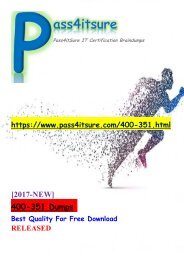
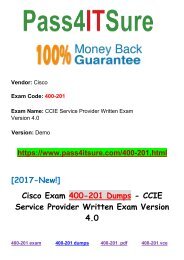


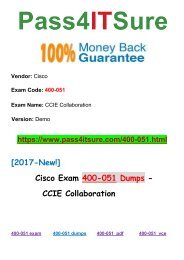
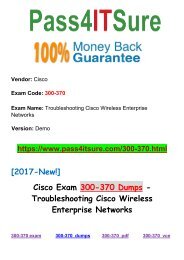
![[2018 New] New Pass4itsure Cisco 300-360 Dumps PDF](https://img.yumpu.com/59902898/1/184x260/2018-new-new-pass4itsure-cisco-300-360-dumps-pdf.jpg?quality=85)
![[2018 New] New Pass4itsure Cisco-300-209 Dumps PDF](https://img.yumpu.com/59873687/1/184x260/2018-new-new-pass4itsure-cisco-300-209-dumps-pdf.jpg?quality=85)
![[2018 New] The Most Effective Pass4itsure Cisco-300-070 Dumps PDF Vce Files](https://img.yumpu.com/59830504/1/184x260/2018-new-the-most-effective-pass4itsure-cisco-300-070-dumps-pdf-vce-files.jpg?quality=85)
![[2018 New] Latest Release Pass4itsure Cisco 210-451 Dumps PDF Question Description](https://img.yumpu.com/59830501/1/184x260/2018-new-latest-release-pass4itsure-cisco-210-451-dumps-pdf-question-description.jpg?quality=85)

![[2018 New] High Pass Rate Pass4itsure 70-734 Dumps PDF Online Exam With New Discount](https://img.yumpu.com/59736925/1/184x260/2018-new-high-pass-rate-pass4itsure-70-734-dumps-pdf-online-exam-with-new-discount.jpg?quality=85)
